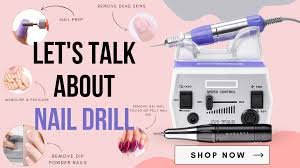
Nail Drill Machine
The nail drill machine is an essential tool in modern nail care, especially in professional salons and advanced home manicures. With the growing popularity of acrylics, gels, and intricate nail art, the need for efficient and precise nail tools has become more prominent than ever. Nail drill machines offer speed, accuracy, and versatility, making them indispensable for both nail technicians and enthusiasts. This article provides a comprehensive overview of nail drill machines, including their components, types, usage, maintenance, safety precautions, and buying considerations.
What is a Nail Drill Machine?
A nail drill machine, also known as an electric nail file, is a handheld device powered by electricity or batteries that rotates at adjustable speeds to shape, buff, smooth, or remove material from nails. Unlike traditional nail files, which rely on manual effort, a nail drill machine automates the process, making it faster and more efficient. These machines are equipped with interchangeable drill bits, each serving a specific purpose such as removing gel polish, reducing cuticles, or preparing the nail bed. Nail drills are especially useful for acrylic and gel nails, as they can precisely file down hard surfaces that manual tools cannot easily manage.
Components of a Nail Drill Machine
A standard nail drill machine consists of several important components that work together to deliver optimal performance. The main unit houses the control system and power source. It features speed adjustment dials or digital displays for accurate control. The handpiece is the part held during use and contains the motor that spins the drill bits. A high-quality handpiece is lightweight, ergonomically designed, and has minimal vibration for ease of use. Drill bits, also called e-files, are inserted into the handpiece and come in various shapes and materials. Other components may include a foot pedal for hands-free speed control, a bit holder, and a dust collector to keep the workspace clean.
Types of Nail Drill Machines
Nail drill machines come in a variety of designs and configurations tailored to different skill levels and purposes.
Corded vs. Cordless
Corded nail drills are powered by plugging them into an electrical outlet. They usually offer consistent power and longer operation times, making them ideal for professional salons. Cordless models, on the other hand, are battery-operated and provide more flexibility and portability. They are perfect for mobile technicians or home users who prefer a clutter-free setup.
Professional vs. Home-Use Models
Professional nail drill machines are designed for extended use and have higher RPM (rotations per minute) capabilities, typically ranging from 20,000 to 35,000 RPM. They offer advanced features such as digital speed displays, reverse function, and heat dissipation systems. Home-use models are simpler, often with lower RPMs (10,000 to 20,000) and fewer features. They are more affordable and sufficient for basic nail maintenance.
Different Types of Drill Bits and Their Functions
Drill bits are the core of a nail drill machine’s functionality. Each bit type is designed for a specific task and is typically made from materials like carbide, ceramic, diamond, or mandrel sanders.
Mandrel and Sanding Bands are commonly used for prepping the nail surface and smoothing out ridges. These are disposable and ideal for beginners. Barrel Bits are used for surface work and shortening acrylics. They are available in smooth top versions for safety near cuticles. Cone Bits are great for removing product near the cuticle area and under the nails. Needle Bits and Flame Bits are used for detailed cleaning and working around the cuticle. Safety Bits have rounded edges and are perfect for beginners or delicate work to avoid injury. Pedicure Bits, often larger and coarser, are used for callus removal and skin smoothing on the feet.
Proper Usage Techniques
Using a nail drill machine correctly is essential to prevent damage to natural nails or discomfort to the client. Always start by sanitizing the equipment and washing your hands. Begin with a lower speed setting, especially when working on natural nails. Select the appropriate bit and insert it securely into the handpiece. Move the drill gently over the nail surface without applying too much pressure. Work in one direction to avoid heat buildup. Use a light touch, letting the machine do the work. When working around the cuticle area, choose safety or fine-grit bits and maintain a steady hand to prevent injury. Frequently check the bit temperature during use to avoid heat-related discomfort. After each use, disinfect the drill bits and clean the handpiece to maintain hygiene and performance.
Benefits of Using a Nail Drill Machine
Nail drill machines offer numerous advantages for both professionals and DIY users. They significantly reduce the time needed for tasks like product removal and shaping. Their precision helps achieve a smooth, salon-quality finish that’s difficult to replicate with manual files. Nail drills are also highly versatile, suitable for natural nails, acrylics, gels, and even for pedicures. For nail technicians, using a drill reduces physical strain on hands and wrists caused by repetitive manual filing. Furthermore, electric drills enable greater creativity in nail art, as they make it easier to sculpt intricate shapes and designs.
Safety and Precautions
While nail drill machines are powerful tools, improper use can lead to serious issues such as nail thinning, burning, cuts, or infections. Therefore, it is crucial to follow safety protocols. Always undergo proper training or tutorials before using a drill, particularly for advanced tasks. Never use a coarse bit on natural nails. Keep the drill at a consistent angle and avoid lingering in one spot to prevent overheating. Do not use dull or damaged bits, as they can slip and cause injury. Ensure the machine is disconnected from power when changing bits or performing maintenance. Store the machine in a dry, clean environment to prevent rust and contamination. It’s also essential to invest in high-quality bits and replace them as needed for optimal performance.
Maintenance and Cleaning
To extend the life of your nail drill machine and maintain hygiene, regular maintenance is necessary. After every session, remove and clean the bits with an antibacterial solution or disinfectant. For deeper cleaning, you can use ultrasonic cleaners designed for salon tools. Wipe down the handpiece with a clean cloth and avoid exposing electrical components to water. Periodically check for dust accumulation inside the handpiece or vents, which can cause the machine to overheat. Use a mini vacuum or air blower to remove fine particles. For machines with a dust collector, clean the filters regularly to ensure proper airflow. Follow the manufacturer’s instructions for lubrication or part replacement if necessary. Consistent maintenance ensures long-lasting performance and keeps clients safe from cross-contamination.
Buying Guide: What to Look For
Choosing the right nail drill machine can be overwhelming due to the wide range of options available. Here are the key factors to consider when purchasing one:
Power and RPM: Look for a model with at least 20,000 RPM for acrylic and gel work. Professional models may go up to 35,000 RPM. More power allows for faster and smoother operation.
Low Noise and Vibration: Choose a machine that runs quietly and with minimal vibration to improve comfort and accuracy.
Ergonomic Design: The handpiece should be lightweight and easy to grip to reduce hand fatigue.
Speed Control and Display: A variable speed dial or digital display gives better control over the process.
Forward/Reverse Function: This feature is useful for switching hands or techniques and improves versatility.
Safety Certification: Ensure the machine is CE, RoHS, or UL certified to guarantee electrical safety.
Bit Compatibility: Make sure the device supports standard 3/32″ bits, which are commonly available and easy to replace.
Portability: If you travel or work on-site, a compact and cordless machine with a long battery life is ideal.
Warranty and Support: A good warranty and customer service support are indicators of a reliable product.
Professional vs. DIY Use: Which Is Right for You?
For professional nail technicians, investing in a high-quality, feature-rich machine is essential for long-term use. These users need reliability, power, and precision throughout their workday. In contrast, beginners or home users may benefit more from a simpler, budget-friendly model that allows them to learn safely. DIY users should focus on safety features like speed control, low heat output, and beginner-friendly drill bits. As skill and confidence grow, upgrading to a more advanced machine becomes worthwhile.
Trends and Innovations in Nail Drill Technology
The beauty industry continues to evolve, and nail drill machines are no exception. Innovations include brushless motors, which run quieter, cooler, and last longer than traditional brushed motors. Rechargeable lithium-ion batteries are making cordless models more efficient. Smart features such as automatic shutoff, overheating protection, and Bluetooth connectivity are now entering the market. Some advanced machines offer touchscreen controls, customizable presets, and ergonomic stands. As the demand for professional-level home beauty tools grows, manufacturers are focusing on compact, portable, and stylish designs without sacrificing performance.
Conclusion: An Indispensable Tool in Modern Nail Care
The nail drill machine has revolutionized nail care by providing precision, speed, and efficiency. Whether you are a seasoned nail technician or a beauty enthusiast learning at home, a good quality nail drill machine can elevate your manicure and pedicure routine to a professional level. However, like any power tool, it must be used responsibly. Understanding its components, functions, safety measures, and proper maintenance is crucial for achieving the best results. With the right machine and a commitment to learning, anyone can master the art of electric filing and enjoy salon-quality nails anytime, anywhere.






